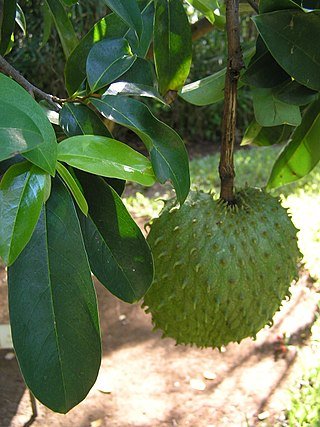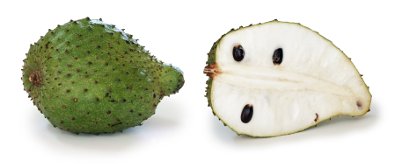Soursop
 Common Names: Soursop, graviola, guyabano
Common Names: Soursop, graviola, guyabano
Scientific Name: Annona muricata
Climate: Warm
Plant Description: It is a medium-height tree that can reach eight to ten meters in height. It bears fruit throughout the year. Soursop is very similar to, and often confused with, cherimoya or custard apple, both being from the Annona family. It is an evergreen or deciduous plant depending on the climate,
The leaves are oblong-elliptical, 6 to 12 cm long by 2.5 to 5 cm wide, and are green. The flowers are solitary, and appear along the stem. They are composed of three oval sepals and six petals. They are yellow.
The fruit can weigh between two and four kilograms and has an elongated shape. The shell is shiny dark green and covered with thorns. The pulp is normally white, soft and juicy, with a sour taste. It contains many black seeds.
Cultivation: Soursop grows best in warm climates, in areas where there is an altitude of 300 to 500 m above sea level. Soils must be moist, sandy and well drained, with an adequate amount of fertilizers. Fertilizers must contain a good amount of nitrogen, potassium and phosphorus, essential to improve the growth of the plant.
Its cultivation can be done by propagating the seed or by grafting. The grafts should be done between the first months of growth of the plant, approximately after five and up to eight months. To avoid the premature fall of leaves and fruits of the plant, it is advisable to plant in a place where they are not affected by the wind.
Weeds around the plant should be removed frequently as they can affect the roots. When the plant is not bearing fruit, it should be pruned to remove dry leaves and branches. The soursop plant should be watered twice a week maximum. Standard irrigation techniques can be used.
 Uses: As well as being a delicious fruit, soursop has numerous medicinal properties. Both its pulp and its leaves are used. Its pulp has vitamins A, B and C, iron, calcium and potassium, all essential for our body. It is also a source of amino acids.
Uses: As well as being a delicious fruit, soursop has numerous medicinal properties. Both its pulp and its leaves are used. Its pulp has vitamins A, B and C, iron, calcium and potassium, all essential for our body. It is also a source of amino acids.
The consumption of this fruit when it is not yet fully ripe helps reduce bilirubin in our body, which causes a yellowish color in our skin and eyes. Significantly lowers high blood pressure, helps improve respiratory conditions such as cough, asthma, bronchospasm, among others. The tea works against stomach aches.
It is a good natural painkiller is the consumption of infusion of soursop leaves. Taking it at night helps us sleep better. This fruit has the property of attacking and stopping the reproduction of malignant cells in our body.
Pests and Diseases: Like the cherimoya, the soursop is affected by the fruit fly and the cottony mealybug that invades the stems and fruits. The fly can be avoided with early harvesting. Neem oil is effective in fighting mealybug. It is not much affected by disease although it can suffer from root rot, among others. This can be avoided by cleaning the base of the tree and ensuring a moderate amount of water.
References:
https://activopr.com/cuidate/2019/10/30/las-propiedades-curativas-la-guanabana.html
https://arbolesfrutales.org/guanabano-todo-lo-que-debes-de-saber/
https://www.scielo.br/scielo.php?script=sci_arttext&pid=S0100-29452014000500005&lng=en&nrm=iso
En español: Guanábana
